Clematis - colour from spring to autumn
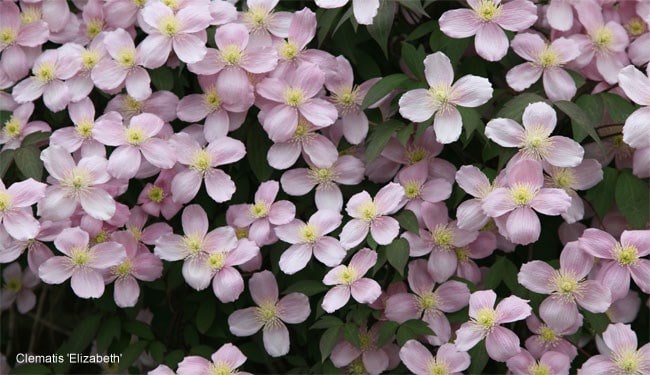 |
Spring is a fantastic planting opportunity for gardeners. The ground finally starts to heat up under a warm sun that actually reaches your back through several layers of clothing. What a eureka moment that is. It's worth catching the moment and planting all sorts of things, including clematis. They take up so little ground space, so even a small garden can support twenty or so, giving you clematis flowers in almost every month of the year.
March and April Flowering Clematis
By late March the buds of spring-flowering clematis (like the macropetalas and alpinas) begin to swell up before they produce their flowers. These vary from wispy ballerina tutus to clean-cut ragged Peter Pan suits. The colours are mainly mid-blue and mauve-pink, but you can find purples and whites too. This group are known as the Atragenes, a mix of species that tend to come from cold, high regions with almost Alpine climates. Like all alpines they demand good drainage and dislike heavy wet soil. You can put lots of grit at the base of the planting hole, but I prefer to tuck mine close to shrubs where the ground has been drained by a network of woody roots. I angle the clematis into the shrub as I plant, untie the stems and remove those annoying plastic ties, before weaving the clematis through. Then I let them get on with it. Although I will water in dry springs, with warmed buckets gently tipped over each plant.
Admittedly the Atragene Group are slower to establish than many clematis. For this reason they should never be pruned hard. Give them a neat spruce after flowering, but only if you need to. Their chief attribute is their ability to survive in cold windy places, due to their alpine provenance. The flowers always appear as the foliage breaks and this explosion of fresh flower set against spring-green leaf is a huge part of their charm. The flowers can also be picked for a small posy vase.
Wispy Macropetalas
 Atragene is the ancient Greek name for clematis, meaning firecracker. Apparently the dry branches of clematis explode noisily when put on a fire. I really want to try this at home. The tutu skirts are labelled under Clematis macropetalas and one of the best and easiest to grow is 'Markham's Pink' bred by William Robinson's Head Gardener at Gravetye Manor in West Sussex. Introduced in 1935, but definitely older, this is a wide mid-pink with touches of cerise at the heart. 'Wesselton', selected by the late Jim Fisk in the late 1990s and named after his Suffolk village near Dunwich, has larger spiders than many in a deeper shade of blue. It's reminiscent of English bluebells in tone, although the tips are paler. 'Lagoon' ( from the famous Jackman nursery in 1958/59) forms a blue, open four-pointed star with a paler middle.
Atragene is the ancient Greek name for clematis, meaning firecracker. Apparently the dry branches of clematis explode noisily when put on a fire. I really want to try this at home. The tutu skirts are labelled under Clematis macropetalas and one of the best and easiest to grow is 'Markham's Pink' bred by William Robinson's Head Gardener at Gravetye Manor in West Sussex. Introduced in 1935, but definitely older, this is a wide mid-pink with touches of cerise at the heart. 'Wesselton', selected by the late Jim Fisk in the late 1990s and named after his Suffolk village near Dunwich, has larger spiders than many in a deeper shade of blue. It's reminiscent of English bluebells in tone, although the tips are paler. 'Lagoon' ( from the famous Jackman nursery in 1958/59) forms a blue, open four-pointed star with a paler middle.
Starry Alpinas
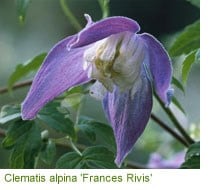 The crisper alpinas have four pointed tepals (petal-like segments). 'Frances Rivis' is one of the best. It was raised by a Suffolk gardener of the same name in 1900, from seed. The real Frances Rivis, for there are two in circulation, has purple-blue slightly twisted tepals.
The crisper alpinas have four pointed tepals (petal-like segments). 'Frances Rivis' is one of the best. It was raised by a Suffolk gardener of the same name in 1900, from seed. The real Frances Rivis, for there are two in circulation, has purple-blue slightly twisted tepals.
Newer Additions
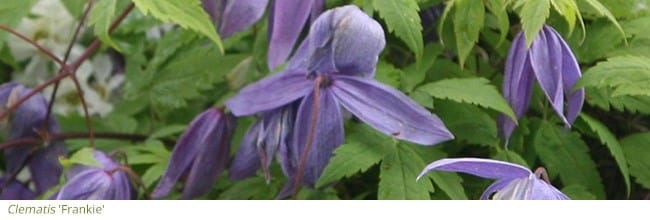 Modern breeding has expanded the gene pool and given thicker petals
Modern breeding has expanded the gene pool and given thicker petals
(from C. koreana) and produced two of my absolute favourites - the two-tone pink 'Propertius' and the aptly named 'Purple Spider'. 'Propertius', raised in Sweden by Magnus Johnson in 1959, combines thickly textured deep-pink tepals surrounding a paler bridesmaid-pink inner frill. It is the prettiest, but not a bit saccharine: so chaps can grow it. 'Purple Spider', found in The Netherlands in 1992, has dark purple flowers that always appear with vivid-green foliage. When the flowers start to break they have black overtones, making 'Purple Spider' completely unique. It also flushes again in summer, when happy. 'Broughton Bride' is at the other end of the spectrum, a soft blush-white.
May Montanas
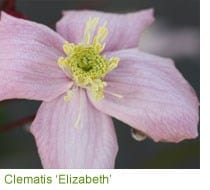 In May the Montanas begin to break into bud. These hail from the Himalaya and can be seen scrambling high into trees. These are the ones that cover the shed, or tickle the bedroom window, or attempt to mask the oil tank. However Montanas need warmth despite their Himalayan roots so again they are only tidied after flowering. They cling to many a south-facing Victorian house wall, as I discovered when stuck on the ring road round Salisbury. Habit and vigour vary, but 'Tetrarose' is a modern tetraploid with bold mauve-pink flowers. The gentler, pale-pink 'Elizabeth' has gappy flowers held on long stems and it's one of the most scented, smelling of vanilla when fully out. Whites tend to flower later.
In May the Montanas begin to break into bud. These hail from the Himalaya and can be seen scrambling high into trees. These are the ones that cover the shed, or tickle the bedroom window, or attempt to mask the oil tank. However Montanas need warmth despite their Himalayan roots so again they are only tidied after flowering. They cling to many a south-facing Victorian house wall, as I discovered when stuck on the ring road round Salisbury. Habit and vigour vary, but 'Tetrarose' is a modern tetraploid with bold mauve-pink flowers. The gentler, pale-pink 'Elizabeth' has gappy flowers held on long stems and it's one of the most scented, smelling of vanilla when fully out. Whites tend to flower later.
Easy Viticellas for Late-Summer
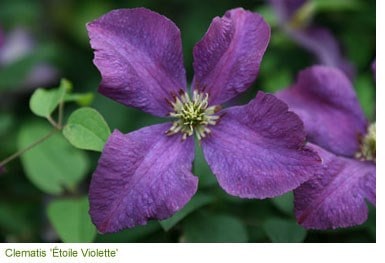 Later flowering clematis include the easiest to grow of all, the viticellas. These flower after midsummer and are cut back hard in March to produce strong new shoots. Some viticellas can have asymmetrical flowers blotched in green, but the most popular tend to have regular flowers in deep-purple and wine-red. They are splendid follow up acts to once and only flowering roses and I have the apricot rambling rose 'Goldfinch' and the purple Clematis 'Étoile Violette' twining round an old post in my own garden. The Clematis Society voted this purple clematis, raised by Morel in France in 1885, into top spot in 2006 - so it must be good! This is the desert island clematis then, early to flower ( by July) and always pristine due to its golden eye.
Later flowering clematis include the easiest to grow of all, the viticellas. These flower after midsummer and are cut back hard in March to produce strong new shoots. Some viticellas can have asymmetrical flowers blotched in green, but the most popular tend to have regular flowers in deep-purple and wine-red. They are splendid follow up acts to once and only flowering roses and I have the apricot rambling rose 'Goldfinch' and the purple Clematis 'Étoile Violette' twining round an old post in my own garden. The Clematis Society voted this purple clematis, raised by Morel in France in 1885, into top spot in 2006 - so it must be good! This is the desert island clematis then, early to flower ( by July) and always pristine due to its golden eye.
|
Clematis Pruning
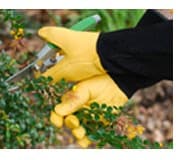 As a general rule all clematis that flower between New Year and late-June are never cut back hard. Those that flower after late-June need to be cut back hard. Do keep your labels in a draw though, as every clematis sold has pruning instructions. As a general rule all clematis that flower between New Year and late-June are never cut back hard. Those that flower after late-June need to be cut back hard. Do keep your labels in a draw though, as every clematis sold has pruning instructions.
 Never plant varieties that need little or no pruning close to viticellas, because you'll be faced with an intertwining jungle of stems and you won't know which to cut and which to leave. Never plant varieties that need little or no pruning close to viticellas, because you'll be faced with an intertwining jungle of stems and you won't know which to cut and which to leave.
| 









 Never plant varieties that need little or no pruning close to viticellas, because you'll be faced with an intertwining jungle of stems and you won't know which to cut and which to leave.
Never plant varieties that need little or no pruning close to viticellas, because you'll be faced with an intertwining jungle of stems and you won't know which to cut and which to leave.